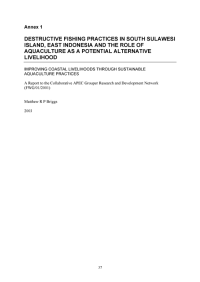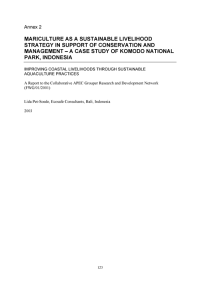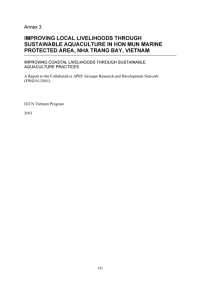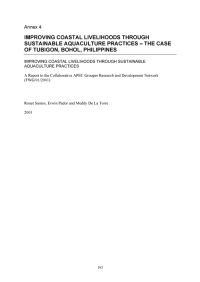Improving coastal livelihoods through sustainable aquaculture practices: Full report
3 February 2004 | Haylor, G., Briggs, M.R.P., Pet-Soede, L., Tung, H., Yen, N.T.H., Adrien, B., O'Callaghan, B., Gow, C., De Vantier, L., Santos, R., Pador, E., de la Torre, M., Bulcock, P., and Savage, W. | 16304 views | .pdf | 2.25 MB | Freshwater finfish, Gender, Genetics and Biodiversity, Inland aquaculture, Livelihoods, gender and social issues, Marine finfish, Aquatic plants, Molluscs (shellfish and other), Shrimp, Crabs and lobsters, Environment and Sustainability, Indonesia, Philippines, Vietnam, Echinoderms (sea cucumbers, urchins)
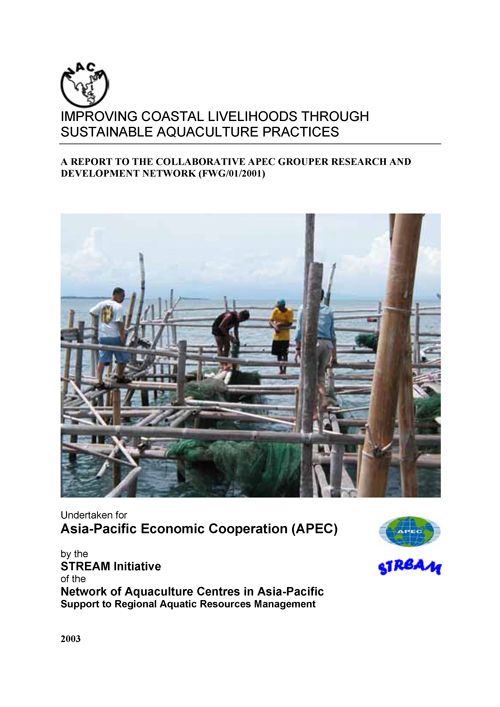
Wild-harvest fisheries for live reef fish are largely over-exploited or unsustainable because of over-fishing and the widespread use of destructive fishing practices such as blast and cyanide fishing. Sustainable aquaculture – such as that of groupers – is one option for meeting the strong demand for reef fish, as well as potentially maintaining or improving the livelihoods of coastal communities. This report from a short study by the STREAM Initiative draws on secondary literature, media sources and four diverse case studies from at-risk reef fisheries, to frame a strategy for encouraging sustainable aquaculture as an alternative to destructive fishing practices. It was undertaken as a component of the APEC-funded project Collaborative Grouper Research and Development Network (FWG/01/2001) to better understand how recent technical advances in grouper culture and other complementary work – including that of the Asia-Pacific Marine Finfish Aquaculture Network (APMFAN) hosted by NACA – could better support the livelihoods of poor coastal communities.
A wealth of marine diversity is found throughout Southeast Asia, although more than three-quarters of the region’s reefs, including those most at-risk, are found in Indonesia and the Philippines, which along with Vietnam form the main focus of this report. The use of explosives to kill fish (so-called blast fishing) and cyanide to stun and capture fish for the live food and aquarium trades are widespread, illegal and destructive, yet lucrative livelihood opportunities for people from coastal communities with neighboring coral reefs. The main instruments to control destructive fishing are a combination of regulation and enforcement, and the identification and promotion of alternative sustainable livelihoods. Through an assessment of a still limited number of studies of coastal livelihoods, of projects and programs in support of alternatives to destructive fishing, and associated literature and media, insights are gained into factors that influence the ability to adopt sustainable sea farming technology. These can be categorised and described as below as technical, environmental planning and management, economic, and social issues.
Technical issues
- Successful technical research and outreach is an essential pre-requisite to the development of livelihood options based on aquaculture. The Gondol Research Institute for Mariculture has been instrumental in the establishment and spread of grouper seed production in Indonesia. This technology has been spread to other countries, including Thailand and Vietnam, through grouper hatchery training courses operated by APMFAN. SEAFDEC AQD also provides training in marine finfish hatchery technology, including grouper production in the Philippines.
- Lucrative destructive practices (such as the use of cyanide in the live reef fish trade) should be discouraged through improving enforcement and patrol. Alternative livelihood options must be sustainable and sufficiently lucrative to compete with destructive practices. Options for local communities might include components of the sustainable rearing of grouper, seahorses, lobsters and especially low-input seaweed culture.
- The availability of a sustainable supply of fingerlings is necessary to empower responsible agencies to support aquaculture, to facilitate supplier-community relations, to support effective, efficient, responsible and sustainable management. A sustainable supply of fingerlings can be achieved through sustainable harvest of wild fingerlings (current wild fry/fingerling supply appears to be unsustainable), or through the development of hatcheries.
- A realistic technical assessment of the status of production technology needs to be undertaken prior to the promotion of aquaculture species. For example, there are still significant technical limitations to the hatchery production of many high-value marine finfish species, including some groupers and wrasse as well as lobsters.
- To support the development of aquaculture for species for which there is no established hatchery technology (e.g., lobster), there is a need to develop sustainable harvest strategies.
- Selecting suitable locations in terms of space, facilities and biological criteria is key to the technical success of sustainable aquaculture, and opportunities to raise more than one species can reduce vulnerability to environmental and market perturbations.
- The hatchery component of the culture of all reef organisms is complex, risk-prone and unlikely to be an immediate option for resource-poor people. Hatcheries to support growout systems suitable for poorer entrepreneurs might be developed by support organisations (e.g., TNC), which in the medium term could be taken over by the private sector. In the longer term, as the technology becomes more robust and less capital intensive, it may become attractive to small-scale operators.
Environmental planning and management issues
- It is fundamental that the central government should have a strong commitment to ending destructive fishing practices and to supporting coastal people’s livelihoods.
- The introduction of sustainable aquaculture practices should be part of a coherent wider program of intervention in coastal resources management, involving the participation of resource users in the design of interventions, along with partnerships with relevant organisations. Adequate social preparation and technical support are necessary to ensure success, and programs should link aquaculture to responsible resource governance.
- Community-based coastal resources co-management with government and the private sector – aimed at combating the lack of integration of development plans and regulatory systems between sectors and tiers of government and industry – is vital.
- Well-managed Marine Protected Areas (MPAs) are internationally recognised as valuable approaches that also support the development of sustainable livelihoods, and may facilitate the shift from destructive fishing to aquaculture. However, currently only a small percentage of MPAs appear to be effectively managed. Improving the design and management of MPAs and local selling of the approach and controls are required.
- Aquaculture development should be promoted only after feed and seed availability is assured and where policies and enforcement mechanisms are in place to guide sustainable development and control unsustainable exploitation.
- Investment in the production of sustainable aquaculture inputs, e.g., local supply of good quality fingerlings produced in a hatchery and the availability of fish feed, is key to sustainable development and would benefit from collaboration with the private sector, perhaps mediated initially through service providers.
- Certification and regulation of sustainable wild collection, and of the aquaculture industry, could provide an incentive for applying best practices and hence safeguard jobs and income of local fishermen, and could support a market niche and or price premium for properly collected and cultured reef fish. Cyanide detection opportunities may help with regulation.
- There is a need for environmental planning and management to reduce impacts. Clustering of grow-out cages is common in Asia, leading to localised pollution, and thus issues of carrying capacity need to be addressed.
Economic issues
- Financial services provision to poor people is essential and should receive priority development support. In this regard, decentralised, flexible community-based savings, micro-credit and insurance schemes are of key importance.
- Being in debt is a constraint for many potential poorer adopters of new livelihood opportunities such as grouper culture, which should not be under-estimated.
- A grouper hatchery is capital-intensive and relatively high-tech for resource poor people. However, grow-out of grouper can be less capital intensive than species such as milkfish, and grow-out of fast-growing species such as Giant Grouper may offer shorter pay-back periods.
Social issues
- A clear understanding of the livelihoods of people fishing destructively is essential to the design of enforcement and patrol as well as the participatory planning and development of service provision in support of alternative opportunities.
A strategy to improve coastal livelihoods would be likely to deal with:
- Asset building, i.e., building new skills, e.g., aquaculture (increasing human capital), encouraging group building and networking (increasing social capital), providing alternative credit (increasing financial capital), and securing entitlement to reef areas (increasing natural capital)
- Strengthening policies, institutions and processes, i.e., formulating a clear policy with the participation of resource users, communicating this policy clearly, enforcement of the policy, and building the capacity of local governments for resource governance.
- Policies and institutional arrangements should support practices that are environmentally and economically sustainable, equitable and coherent, to promote aquaculture systems that are at a scale which is technically and economically feasible yet provide a return that is competitive with destructive fishing practices.
- Information services (technical, legal and financial) are essential and should receive priority development support. The use of mass communications approaches to complement traditional extension may make most effective use of resources.
- From the case studies, it appears that many fishers do not appreciate that fishing practices can be destructive or that marine resources are finite. There is a clear rationale for appropriate education on these issues.
A strategic planning framework is presented, comprising four stages:
- Analysis (so that plans are based on a comprehensive understanding of local institutions and policy, people’s livelihoods, successful ways of working and communications opportunities).
- Knowledge (detailing policy, legislation, people’s assets, objectives and influences, institutional relationships, funds and access to information types).
- Constituency building (negotiating, partnerships, building awareness and consensus, networking).
- Action (participatory selection, planning and implementation of development options).
The elements comprising each stage are deconstructed, drawing on case study partners’ individual experiences with coastal communities and attempts to discourage destructive fishing practices and to encourage sustainable livelihoods.
Further work is necessary to review the existing best practices in relation to each of the stages of the strategic planning framework and to address any gaps in knowledge and processes. This should be undertaken as a study which draws on learning and literature, including from related fields, to guide the detailed implementation of the strategy for improving coastal livelihoods.
Copyright, all rights reserved.

